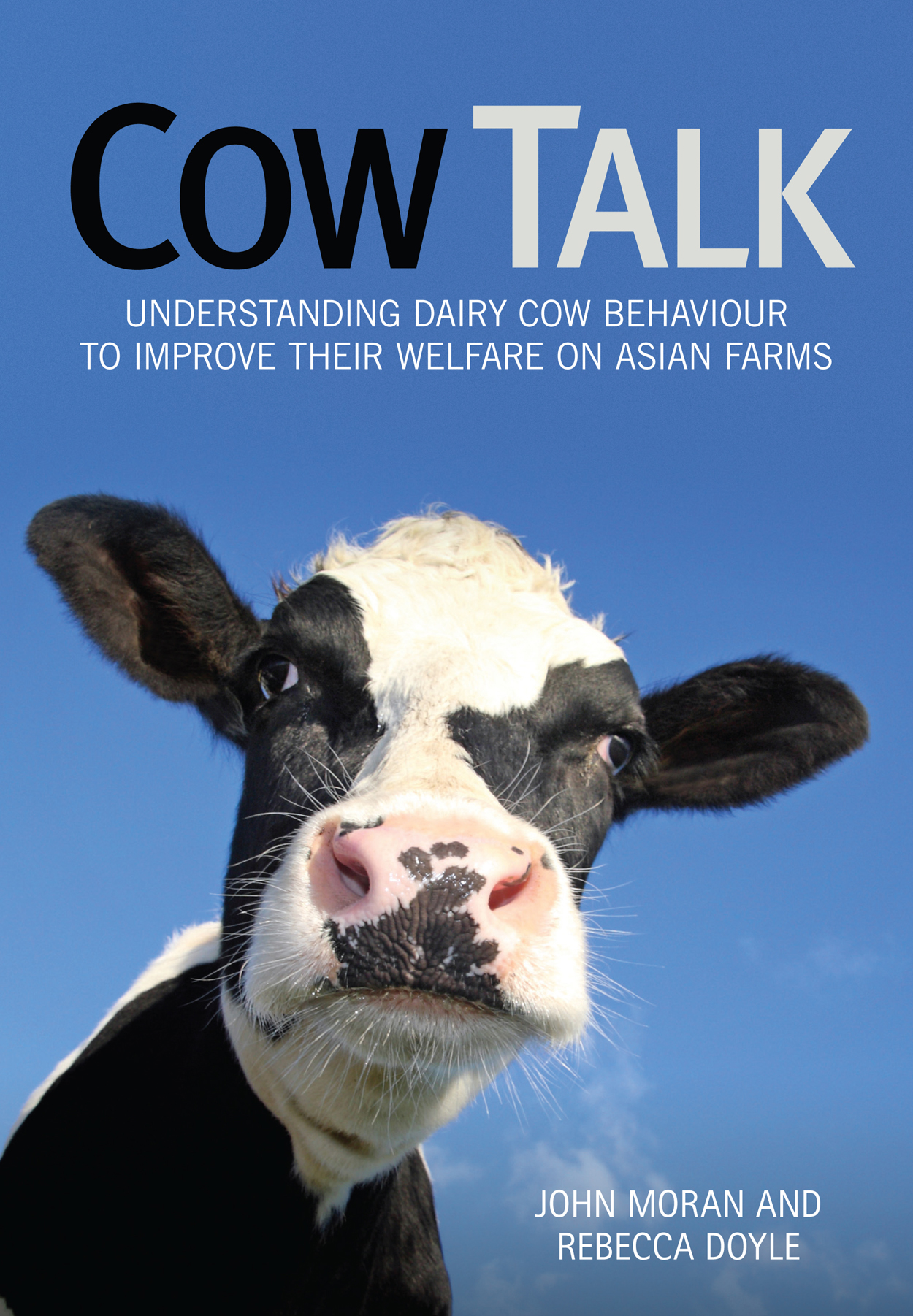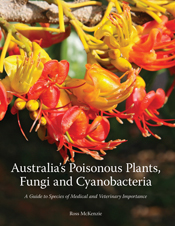Cow Talk

This manual provides farmers with a better understanding of animal behaviour and the ways cattle communicate their comfort or distress.
The aim of this manual is to improve the welfare of dairy cattle in tropical developing countries, and by doing so, optimise cow and herd performance. It gives the stockmen and farmers directly concerned with the cattle a better understanding of animal behaviour and the ways cattle communicate their comfort or distress. The book discusses normal cattle behaviour and shows how domestication and breeding can affect behaviour to achieve high levels of production of milk, live weight gain and fertility. + Full description
Animal welfare is important for producers because it can affect the health, production and contentment of cows. Animal welfare practices which adversely affect cow and herd performance on tropical small holder dairy farms are identified. Advice is then given to change the animal's environment or modify a handler's technique to ensure cattle have the degree of comfort needed to achieve more profitable and sustainable systems of livestock farming.
Cow Talk will be a beneficial resource for farmers who want to improve animal welfare, farm advisers who can assist farmers to improve their welfare practices, educators who develop training programs for farmers and dairy advisers, and other stakeholders in tropical dairy production such as local agribusiness, policy makers and research scientists.
- Short descriptionNews
No longer available in a print edition.
Listen to one of the authors of Cow Talk, Rebecca Doyle, interviewed on Radio National’s Off Track program about the surprising internal and social life of cows.
Features
- Addresses the key issues of animal welfare practices of dairy stock on tropical small holder dairy farms, highlighting those which are likely to adversely affect cow and herd performance.
- The reader will better understand the history of cattle domestication, the principles of their behaviour patterns and how these relate to a better understanding of their needs to cope with their surroundings.
CSIRO Publishing would like to thank the Crawford Fund whose generous financial support made the publication of this work possible.
Contents
ForewordAbout the authors
Other books and technical manuals by the senior author
Acknowledgments
Acknowledgments of The Crawford Fund
Chemical warning
Chapter 1: Introduction
1.1 What this book is all about
1.2 Outline of this book
1.3 Smallholder dairy development in tropical Asia
1.4 What do dairy cows really want?
Chapter 2: Cow welfare
2.1 What is animal welfare?
2.2 Why animal welfare is important
2.3 Who should be responsible for animal welfare?
2.4 Common welfare issues on dairy farms
2.4.1 Morbidity and mortality
2.4.2 Behavioural abnormalities
2.4.3 Housing
2.4.4 Lameness
2.4.5 Heat stress
2.4.5 Tethering
2.4.6 Painful husbandry practices
2.4.7 Calf management
2.5 Animal welfare resources and international regulatory agencies
Chapter 3: The implications of cattle domestication
3.1 How modern day cattle evolved
3.2 Impacts of domestication
3.3 Impacts on behaviour
3.3.1 Housing
3.3.2 Lameness
3.3.3 Social influences
3.3.4 Interactions with humans
Chapter 4: Cattle behaviour
4.1 The development of cow behaviour
4.2 The five senses
4.2.1 Vision
4.2.2 Hearing
4.2.3 Smell
4.2.4 Taste
4.2.5 Touch
4.3 Behavioural indicators of poor welfare
4.3.1 Pain and its detection
4.3.2 Fear and its implications
4.3.3 Descriptors of cow behaviour
4.3.4 Stereotypic behaviours
4.4 Animal movement
4.4.1 Flight zone and its point of balance
4.4.2 Individual animal movement
4.4.3 Herd movement
4.5 Social behaviours
4.5.1 Visual communication
4.5.2 Vocal communication
4.5.3 Reproductive behaviour
4.5.4 Cow-calf bonding
4.5.5 Communicating with the calf
4.5.6 Social dynamics in free moving herds
4.6 Cattle-human interactions
4.6.1 Temperament
4.6.2 The behaviour of the calf handler
4.6.3 Cowpersonship
4.7 Practical ways to improve cow flow
4.7.1 Poor movement can be solved with simple observation
4.7.2 Improving cow flow
4.8 Recent behavioural problems arising in cattle
4.8.1 Calves will not suckle
4.8.2 Cows refusing to use their stalls
4.8.3 Nymphomania
4.8.4 Silent heat
4.8.5 Aggressive behaviours
4.8.6 Feed related vices
4.8.7 Kicking
4.8.8 Changes in normal behaviour
Chapter 5: Observing cow signals
5.1 Introduction
5.2 Don’t just look; Observe
5.2.1 Differences between animals
5.2.2 Logic of cow signals
5.2.3 Indicator animals and locations
5.2.4 Risk management
5.2.5 Success factors
5.3 Cow signals while grazing
5.3.1 Leg and hoof health
5.3.2 Signals of good and poor health
5.4 Cow signals in the cow shed
5.4.1 Space and social order
5.4.2 Shed design and construction
5.4.3 Stalls or cubicles
5.5 Cow signals at the feed trough
5.5.1 What signals to look for
5.5.2 Considerations when preparing the ration
5.5.3 Risk groups
5.6.1 Cow signals in the milking parlour
5.6.2 Cow behaviour during milking
5.6.2 Cleanliness, hygiene and cow health
5.7 Signals given out by calves and heifers
5.8 Signals given out by dry cows
5.9 Cow signals of heat stress
5.9.1 Symptoms of heat stress
5.9.2 The Temperature Humidity Index
5.9.3 Using respiration rates as a guide to heat stress
Chapter 6: Quantifying cow signals
6.1 Scoring body condition
6.2 Locomotion and lameness scoring
6.3 Hoof scoring
6.4 Leg scoring
6.5 Scoring cow cleanliness
6.6 Rumen scoring
6.7 Dung scoring
6.8 Teat scoring
6.9 Panting score
Chapter 7: Cow comfort
7.1 Introduction
7.1.1 What is cow comfort?
7.1.2 Physical cow comfort
7.1.3 Building for the cow
7.2 Stalls for shedded cows
7.2.1 Tie stalls
7.2.2 Loose housing
7.2.3 Free stalls
7.2.4 Monitoring free stall use
7.2.5 Straw yards
7.3 Other cow shed equipment
7.3.1 Cow cooling equipment
7.3.2 Facilities and equipment for young stock
7.3.3 Facilities and equipment for additional health care
7.3.4 High cost equipment
7.4 Examples of complete cow housing systems
7.4.1 Sri Lankan example
7.4.2 Vietnam example
Chapter 8: Auditing cow welfare
8.1 Indicators of animal welfare
8.1.1 The five basic freedoms of livestock
8.1.2 Key Performance Indicators of cattle welfare
8.1.3 A simplified scoring system for assessing dairy cow welfare
8.2 Case studies of dairy cow welfare
8.2.1 Results from a UK study of dairy cow welfare indicators
8.2.2 Results from an African study highlighting poor cow welfare
Chapter 9: Stock management on Asian small holder dairy farms
9.1 Dairy farming in the developing tropics
9.2 Shedding dairy stock in tropical Asia
9.2.1 Why are dairy stock generally housed in tropical Asia?
9.2.2 Problems of confinement
9.2.3 The potential role for cow colonies
9.3 Constraints to farm performance and profitability
9.3.1 The supply chain for profitable dairy farming
9.3.2 Identifying the key constraints to animal welfare within the supply chain
9.3.3 Farm Key Performance Indicators and animal welfare
9.3.4 Assessing adequacy of the current herd management using cow milk yields
9.3.5 A case study of smallholder dairy farming in Indonesia
9.3.6 A case study of smallholder dairy farming in Malaysia
9.4 A check list to assess current farm management and herd welfare
Chapter 10: A protocol for the welfare of stock on tropical small holder dairy farms
10.1 Standard Operating Procedures
10.2 Animal welfare protocols for dairy stock on tropical small holder farms
10.2.1 Ensure animals are free from hunger and thirst
10.2.2 Ensure animals are free from discomfort
10.2.3 Ensure animals are free from pain, injury and disease
10.2.4 Ensure animals are free from fear and distress
10.2.5 Ensure animals are free to express normal behaviour
Chapter 11: Conclusions
11.1 Considering current production constraints on tropical dairy farms
11.2 The genotypes of dairy stock imported onto tropical dairy farms
11.3 The role for model farms
11.3.1 Modus operandi of a model farm
11.3.2 Examples of improved management practices
11.4 In summary
Appendices
Abbreviations
Glossary
References and further reading
Index
Authors
Dr John Moran is a consultant with Profitable Dairy Systems, located in Kyabram, Victoria. His specialist fields include dairy production, ruminant nutrition, calf and heifer rearing, forage conservation and whole farm business management. Since 1999, he has conducted training programs on small holder dairy production to farmers, advisers and policy makers in Indonesia, Malaysia, Thailand, Vietnam, China, Pakistan, Sri Lanka, Bangladesh, Myanmar and East Timor. In 2013 he was appointed as the Coordinator of the Asia Dairy Network, an international agency position to facilitate communication and collaboration of dairy industries from 15 countries throughout South and East Asia.Dr Rebecca Doyle has worked in the area of ruminant welfare since 2007. After completing her PhD in 2010, Rebecca joined Charles Sturt University in Wagga Wagga, NSW, as lecturer in animal physiology and welfare. She has since worked with the beef cattle industry, both in Australia and Indonesia, to improve the welfare of exported cattle. In addition, Rebecca has conducted stock handling and welfare training programs for export sheep in the Middle East.








